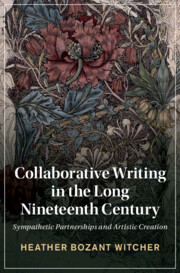Book contents
- Collaborative Writing in the Long Nineteenth Century
- Cambridge Studies in Nineteenth-Century Literature and Culture
- Collaborative Writing in the Long Nineteenth Century
- Copyright page
- Dedication
- Contents
- Figures
- Acknowledgments
- Introduction
- Chapter 1 Adam Smith’s Liberal Sympathy
- Chapter 2 “O You Pretty Pecksie!”
- Chapter 3 Written–Visual Aesthetics
- Chapter 4 Typographical Adventures
- Chapter 5 Sim and Puss
- Chapter 6 Towards Empathy
- Conclusion
- Notes
- Bibliography
- Index
- Cambridge Studies in Nineteenth-Century Literature and Culture
Chapter 2 - “O You Pretty Pecksie!”
The Collaborative Process of Mary Shelley and Percy Bysshe Shelley
Published online by Cambridge University Press: 12 March 2022
- Collaborative Writing in the Long Nineteenth Century
- Cambridge Studies in Nineteenth-Century Literature and Culture
- Collaborative Writing in the Long Nineteenth Century
- Copyright page
- Dedication
- Contents
- Figures
- Acknowledgments
- Introduction
- Chapter 1 Adam Smith’s Liberal Sympathy
- Chapter 2 “O You Pretty Pecksie!”
- Chapter 3 Written–Visual Aesthetics
- Chapter 4 Typographical Adventures
- Chapter 5 Sim and Puss
- Chapter 6 Towards Empathy
- Conclusion
- Notes
- Bibliography
- Index
- Cambridge Studies in Nineteenth-Century Literature and Culture
Summary
Chapter 2 explores the 1814 collaboration between Mary and Percy Bysshe Shelley and extends scholarly attention to their travel journals, before discussing Frankenstein. Using the couple’s shared journal as a way of marking their convergence and redefinition of themselves from a singular identity to a shared pluralism, the journal’s entries witness a shared understanding – a sympathetic concord – between the couple. This close examination of the collaborative process indicates a willingness to assimilate and accommodate the other’s sentiments and formal constructs. While the narratives of these entries show the completion of each other’s thoughts and a reliance upon readerly circulation, the entries’ form also gestures to their defined plural identity through a vocal blending. With its sustained focus on the sympathetic communities developed by the couple and increased literary production as a result of this lived communal experience, I suggest that the Shelley collaboration ultimately shapes the narrative form of Frankenstein. The novel’s layered narrative of sympathetic texts makes possible a view of the collaborative compilation of the novel as a means of social reform: a view of society that relies upon the affective bonds of sympathy with a community of people, whether imaginative or genuine.
- Type
- Chapter
- Information
- Collaborative Writing in the Long Nineteenth CenturySympathetic Partnerships and Artistic Creation, pp. 31 - 63Publisher: Cambridge University PressPrint publication year: 2022

